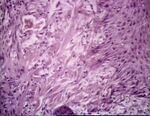Category:Chronic Inflammation
Types
Granulomatous Inflammation
- Granulomatous inflammation is usually caused by organisms of low virulence but great persistence, or by implanted foreign bodies.
- Classically appears as a granuloma.
- NOT a tumour, despite the suffix "-oma".
- A circumscribed sphere of chronic inflammatory cells enveloped by poorly organised attempts at encapsulation by local connective tissue.
- The differences between a granuloma and an abscess must be appreciated.
- The fibrous envelope is never as well developed as that of an abscess.
- The inner contents are never as completely fluid as in an abscess.
Structure of a Granuloma
Central core
- The central core which contains the agent.
- The agent may be visible with H&E staining in section, e.g.
- Actinobacillus lignieresii
- The cause of "Wooden tongue" in cattle.
- Appears as a granule, with a central core of the bacterial colony surrounded by radiating eosinophilic "clubs".
- Clubs are considered to be formed from degenerating collagen and antigen-antibody complexes.
- Actinomyces bovis
- The cause of "Lumpy Jaw" in cattle.
- Forms granules containing bacteria and "clubs".
- Fungal hyphae
- Parasitic larvae
- Foreign bodies
- Actinobacillus lignieresii
- The agent might not be visible without being selectively stained.
- E.g. Mycobacterium tuberculosis and Brucella abortus.
- Stain using an acid-fast stain (Ziehl-Neelsen), or a modification.
- These organisms are intracellular in the macrophages.
- E.g. Mycobacterium tuberculosis and Brucella abortus.
Chronic Inflammatory Cells
- Outside the core is a substantial number of chronic inflammatory cells.
- Mainly macrophages.
- Often appear as epithelioid cells.
- Lymphocytes
- Plasma cells.
- Mainly macrophages.
- Neutrophils and necrotic remnants of cells can be quite prominent in the granulomas of Actinobacillus and Actinomyces species.
- Eosinophils are prominent in parasitic granulomas.
- A scattered and variable number of Giant cells are often seen, but not always in every granuloma.
Outer Envelope
- The final layer is an outer envelope of incomplete fibrous tissue.
- Giant cells can also be seen in this area.
Gross Appearance of Granulomas
- The cut surface of granulomas varies considerably;
- Tuberculous granulomas tend to have solid whitish cores which are often calcified.
- Grate on the knife when cut through.
- Parasitic granulomas are often greenish in colour due to the substantial numbers of eosinophils.
- Older ones are also often calcified.
- Actinobacillus and Actinomyces species often have liquefied cores due to the necrosis and neutrophils.
- I.e. they are purulent.
- May discharge to the surface along sinus tracts.
- The central core of bacteria and ‘clubs’ may appear as yellowish granules in this pus.
- Often called "sulphur granules".
- Tuberculous granulomas tend to have solid whitish cores which are often calcified.
Granulation Tissue
- Is completlely different to granulomatous inflammation, despite the similarity in name!
- Occurs on the surface of the skin where large areas of the epithelium have been lost.
- Makes up the lining of sinus tracts discharging from deeper lesions.
- Takes its name from the gross appearance of the small vessels which appear at the surface.
- Look like red granules.
- These vessels supply inflammatory cells, mainly neutrophils, to the infected surface.
- The most frequent example in domestic animals is the formation of excessive granulation tissue on the legs of horses with poorly healing wounds.
- "Proud flesh"
- Ulcers and open wounds may heal by granulation.
Lymphocytic Inflammation
- Lymphocytic inflammation is a diffuse chronic ongoing inflammation.
- Seen in:
- Diseases of the central nervous system.
- Lymphocytes appear microscopically as several layers of cells around blood vessels in the perivascular space.
- They indicate that there is damage to the nervous tissue further in.
- Should alert to the possibility of viral infection, which is a common cause of central nervous system disease.
- E.g. louping ill.
- Should alert to the possibility of viral infection, which is a common cause of central nervous system disease.
- The gut.
- An excessive number of lymphocytes diffusely infiltrating the lamina propria, often in conjunction with plasma cells, indicate an ongoing non-specific chronic enteritis.
- The respiratory tract.
- Peribronchial and peribronchiolar cuffing may occur to the point of actual lymphoid follicle formation in these areas.
- Follicles are sometimes large enough to cause partial occlusion of the airways.
- A feature of some chronic lung diseases.
- Ee.g. Mycoplasmosis in swine and calves.
- Peribronchial and peribronchiolar cuffing may occur to the point of actual lymphoid follicle formation in these areas.
- Diseases of the central nervous system.
Pages in category "Chronic Inflammation"
The following 4 pages are in this category, out of 4 total.
